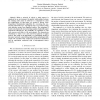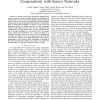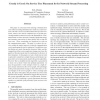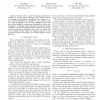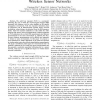IEEECIT
2006
IEEE
14 years 5 months ago
2006
IEEE
Localization is a basic and critical requirement for wireless sensor network applications, e.g. target tracking, monitoring and intrusion detection. In the received signal strengt...
ICRA
2006
IEEE
14 years 5 months ago
2006
IEEE
— We address the problem of placing a sensor network so as to minimize the uncertainty in estimating the position of targets. The novelty of our formulation is in the sensing mod...
ICRA
2006
IEEE
14 years 5 months ago
2006
IEEE
— When a network of robots or static sensors is emplaced in an environment, the spatial relationships between the sensing units must be inferred or computed for most key applicat...
ICRA
2006
IEEE
14 years 5 months ago
2006
IEEE
— A mobile robot we have developed is equipped with sensors to measure range to landmarks and can simultaneously localize itself as well as locate the landmarks. This modality is...
ICDCS
2006
IEEE
14 years 5 months ago
2006
IEEE
This paper is concerned with reducing communication costs when executing distributed user tasks in a sensor network. We take a service-oriented abstraction of sensor networks, whe...
GLOBECOM
2006
IEEE
14 years 5 months ago
2006
IEEE
— The paper presents IRIS, an Integrated Routing and Interest dissemination System for wireless sensor networks. The proposed protocols are designed to work under very low duty c...
GLOBECOM
2006
IEEE
14 years 5 months ago
2006
IEEE
— In this work, we study the topology enhancement problem of wireless sensor networks. Our research focuses on reducing the path-based vulnerability. The objective is to get as m...
GLOBECOM
2006
IEEE
14 years 5 months ago
2006
IEEE
— The path loss exponent (PLE) is a parameter indicating the rate at which the received signal strength (RSS) decreases with distance, and its value depends on the specific prop...
DSD
2006
IEEE
14 years 5 months ago
2006
IEEE
Wireless sensor networks (WSN) are composed of battery-driven communication entities performing multiple, usually different tasks. In order to complete a given task, all sensor no...
DATE
2006
IEEE
14 years 5 months ago
2006
IEEE
—Wireless Sensor Networks provide opportunities even outside their usual application domain of environmental monitoring. In this paper we present a case study on the use of Wirel...

